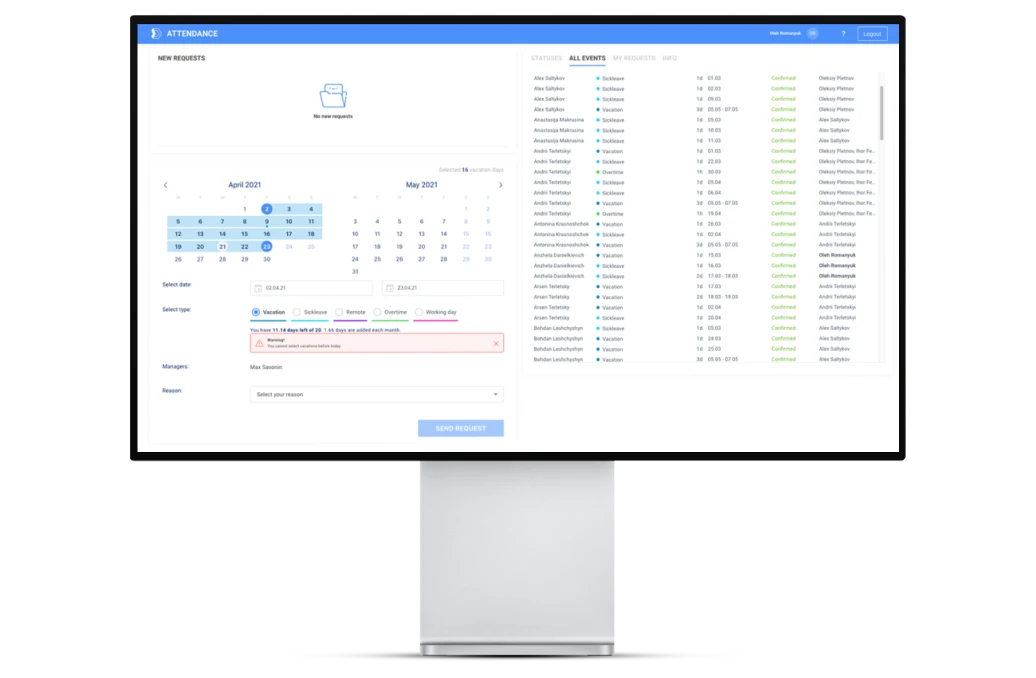Many firms are interested in low-code development. In this article, we’ll show that the interest isn’t misplaced: the benefits of low-code development are indeed powerful!
Development is a complex process that is often very costly and long-term. Sometimes, however, firms need software that is cheap and fast to develop. In the past, there was no way around this problem. Today, however, there’s a solution to this issue in the form of low-code platforms. A low-code development platform allows the creation of apps for business users with minimal use of code. Development occurs through a comfortable user interface that nonetheless enables the creation of complex applications. Anything not covered by the low-code platforms can later be added through custom code. Thus, it’s possible to reduce the price of many applications by 40% and more and deliver an MVP for them within 2–4 weeks instead of the 6-8 usually necessary for this goal.
Benefits of Using Low-Code Development

Multiple important benefits of low-code development attract professional developers. The combination of development teams with the so-called citizen developers, non-professionals creating apps through low-code platforms, enables the following long-term benefits:
Improved productivity
Low-code development tools are notable for their ability to improve long-term productivity for diverging teams of developers. Why is this the case? Firstly, the ability to simply drag and drop certain elements into a user interface and have it work from the onset reduces the overall development time significantly. Features that may take several hours to code can require only one hour to arrange with low-code application development. Secondly, the platforms enable citizen developers to offer their input. A core problem for many developers is communication. Now, business leaders can personally enter the development environments and introduce varying changes that they see as vital for particular projects. This critical ease of communication is among the core benefits of low-code development these days.
Reduced costs
The simplification of the development process leads to lower development costs. Low-code development requires smaller teams that will need less time than traditional developers for the creation of an app. Even with similar payment per hour, low-code application development platforms are markedly cheaper. Our experience shows a decrease of at least 40% in certain situations over traditional development approaches. These low resource requirements are, in our opinion, one of the core reasons why minimal coding environments are likely to be the future of the development field.
Easy flexibility and scalability
Low-code platforms tend to focus on mobile and web development, using languages that fit their requirements. Dart used in FlutterFlow, for example, is notable for its capability to scale well and be flexible across multiple platforms. Firstly, Dart can easily work with small apps and offer operational efficiencies even for some large-scale applications. Secondly, it’s capable of working across several platforms with one codebase. You can also transform the pre-built components in low-code platforms through other programming languages. This is a perfect way to enhance customer experiences and offer intuitive user interfaces with relatively low effort.
Ease of cooperation
It’s very easy to cooperate by using low-code apps. Firstly, they have great interfaces for the cooperation between skilled developers. Everything occurs in a singular platform with high-quality sharing tools. Secondly, basic applications can also be modified by citizen developers. Non-experts of various kinds may offer their input through the presented systems, greatly improving the interaction between diverging departments of your organization. The ability to include input from various non-developer specialists is undoubtedly among the core reasons to use low-code platforms.
Fast development
As we’ve mentioned before, one of the basic benefits of low-code development is its ability to present results quickly. You can enjoy a faster time to market because the majority of features require a simple drag-and-drop action rather than a full-scale coding development process. In this regard, our experience shows that it’s possible to reduce the average development time by almost two times through platforms like FlutterFlow. For example, while creating a Real Estate Management Project Landing Page, which you can review in our portfolio, we’ve managed to deliver a fully functioning product within a mere 1.5 weeks despite a very small development team. Typically, this process can take up to a month with a larger team.
Better user experience
App development through platforms such as FlutterFlow goes beyond improving development time. The relevant framework has been created with business apps in mind. Consequently, it’s optimized from the onset to the business requirements. Blocks in low-code solutions undergo constant testing to ensure that they deliver the best user experience. Thus, one of the core benefits of low-code is also its capability to deliver a great user experience despite the relatively low development effort. In low-code platforms, every element is already pre-optimized to ensure that your users have the best experience possible.
What is Possible to Build With Low-Code?

The key benefit of low-code platforms is that they help create a wide range of solutions despite the minimal investments, promoting significant cost savings in comparison to legacy systems. Below is a brief overview of what is usually possible:
- Business applications
- Customer relationship management (CRM) systems
- Inventory management tools
- Project management platforms
- Mobile apps
- Both iOS and Android applications
- Internal company apps or consumer-facing products
- Web applications
- E-commerce sites
- Booking systems
- Customer portals
- Workflow automation
- Approval processes
- Document routing
- Task management systems
- Data visualization tools
- Dashboards
- Reports
- Interactive charts
- Forms and surveys
- Data collection tools
- Feedback systems
- Integration solutions
- Connecting different software systems
- API-based integrations
- Simple AI/ML implementations
- Chatbots
- Basic predictive models
- IoT applications
- Device monitoring dashboards
- Simple control interfaces
These solutions can vary in complexity and scale depending on the specific low-code platform used. Low-code approach allows delivering functional applications both for individual non-business users and even full-scale enterprise applications. Still, while low-code/no-code platforms are powerful, they may have limitations for highly complex or unique requirements. In this light, it’s essential to consult experts before considering the employment of a particular low-code tool for software applications.
What’s The Difference Between Low-Code and Traditional Application Development?

Here are the core differences between low-code and traditional development:
- Development approach:
- Low-code: Development is visuals-oriented, using drag-and-drop tools and other pre-built components;
- Traditional: coding is done manually, requiring traditional methods of software-oriented thinking.
- Skill level required:
- Low-code: requires technical skills but doesn’t necessitate advanced knowledge of coding;
- Traditional: needs advanced knowledge of the software development process.
- Speed of development:
- Low-code: fast, especially if an application is relatively simple;
- Traditional: slower but software development process has more customizability.
- Customization:
- Low-code: limited by the existing platform capabilities and the pre-built elements those digital solutions offer;
- Traditional: highly customizable as long as developers have enough time and their clients can cover the cost of development.
- Scalability:
- Low-code: major limitations for large or complex applications, but some platforms focus on resolving this issue through unique programming languages;
- Traditional: potentially higher scalability for enterprise solutions, limited by the cost of development.
- Maintenance:
- Low-code: visual approach makes maintenance very simple;
- Traditional: requires advanced technical knowledge and coding skills.
- Cost:
- Low-code: initial development costs are usually lower, but may have ongoing platform fees;
- Traditional: higher upfront costs due to coding skills requirements, but they might be lower in the long run.
- Integration:
- Low-code: often offers pre-built integrations, but is typically limited only to them;
- Traditional: all types of custom integrations are possible.
- Performance:
- Low-code: limited by the capabilities of low-code/no-code technology;
- Traditional: coding flexibility enables maximal optimization but at a high cost.
- Learning curve:
- Low-code: basic applications require a rather short learning curve;
- Traditional: very difficult learning curve, but market opportunities for creating complex apps tend to be much more expansive.
Conclusions
To summarize, low-code and no-code development is likely to be a worthwhile investment. It allows delivering simple- and medium-complexity apps fast and with minimal costs due to drag-and-drop interfaces. Our experience with the technology shows that it enables the reduction of development costs by 40% and more. Projects like landing pages can be completed within 1.5 weeks, and even faster in cases of smaller products. Keenethics has multiple years of experience in no-code and low-code development. You can address us to produce a full-scale enterprise solution through the usage of those tools.
Try low-code solutions together with Keenethics to achieve this goal!
FAQ
What is low-code development, and how is it implemented?
Who can take advantage of low-code development tools?
In our opinion, almost every company. If you need to develop a tool with a potentially 40% lower development cost, the low-code approach is among the best choices.
What the low-code development process is like?
A developer uses a drag-and-drop interface to create an app according to your design requirements on platforms such as Figma. Then, the development team adds some custom elements through the unique programming languages used in low-code platforms.
Is it safe to use low-code development?
Yes, those platforms are safe. They’re updated constantly and, hence, represent a safety profile similar to all other projects on the market.
What is the best way to start low-code development in my organization?
You can contact a low-code firm like ours. Keenethics has multiple years of experience when it comes to no-code and low-code solutions. Thus, we can offer you developers capable of creating high-quality no-code apps.
 Search
Search













